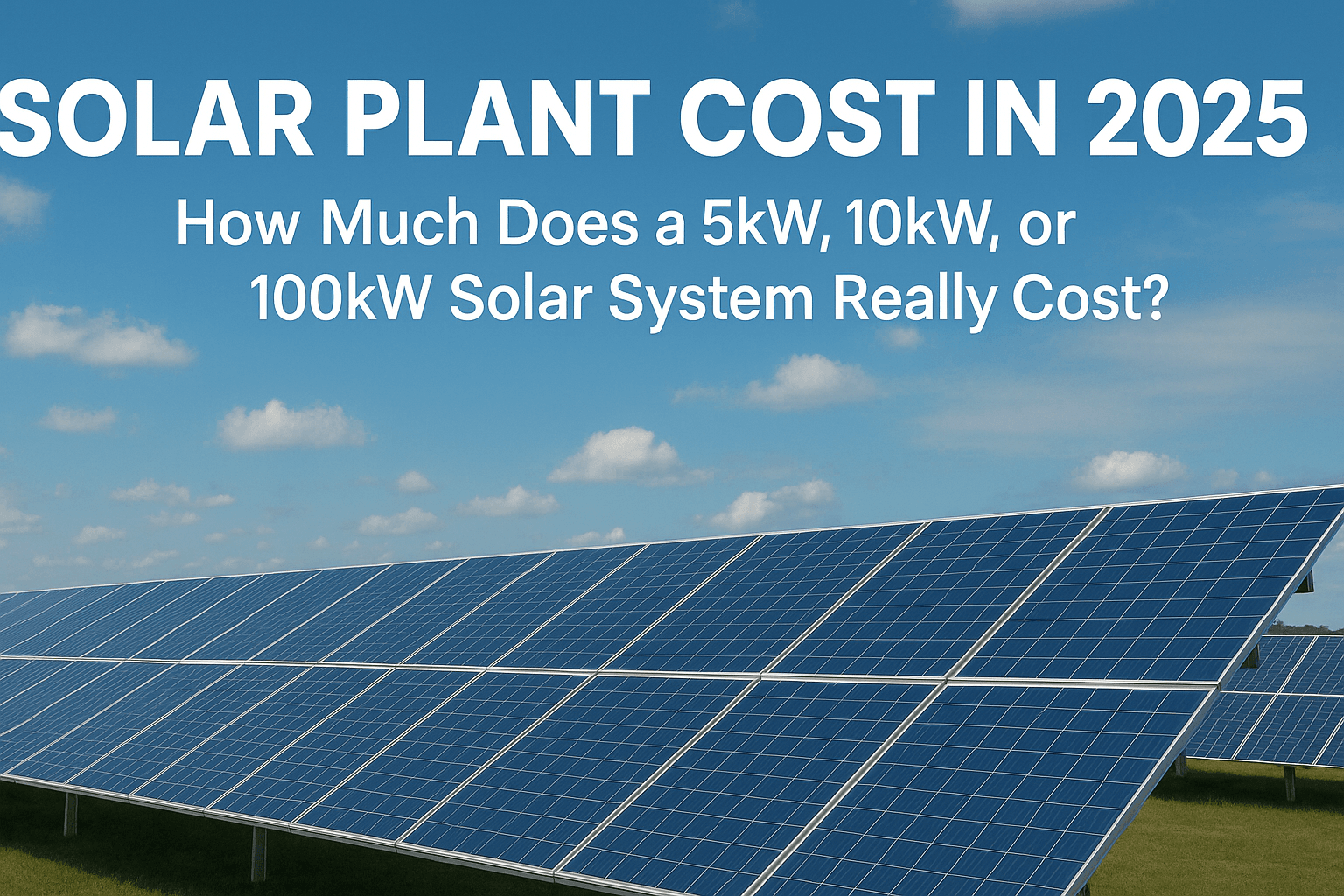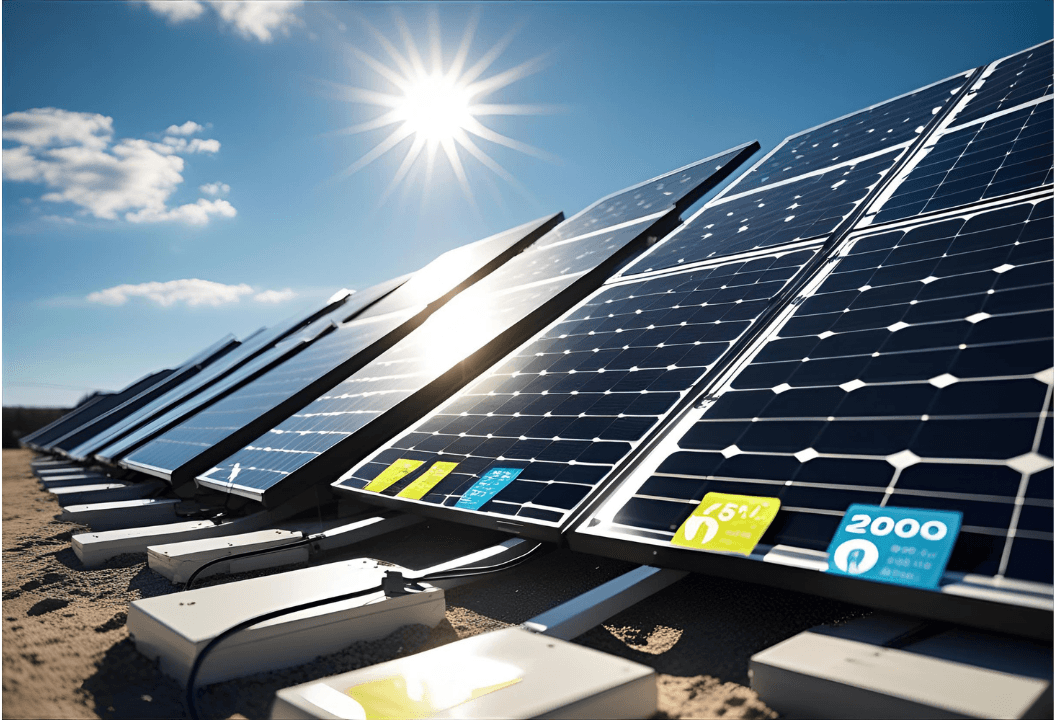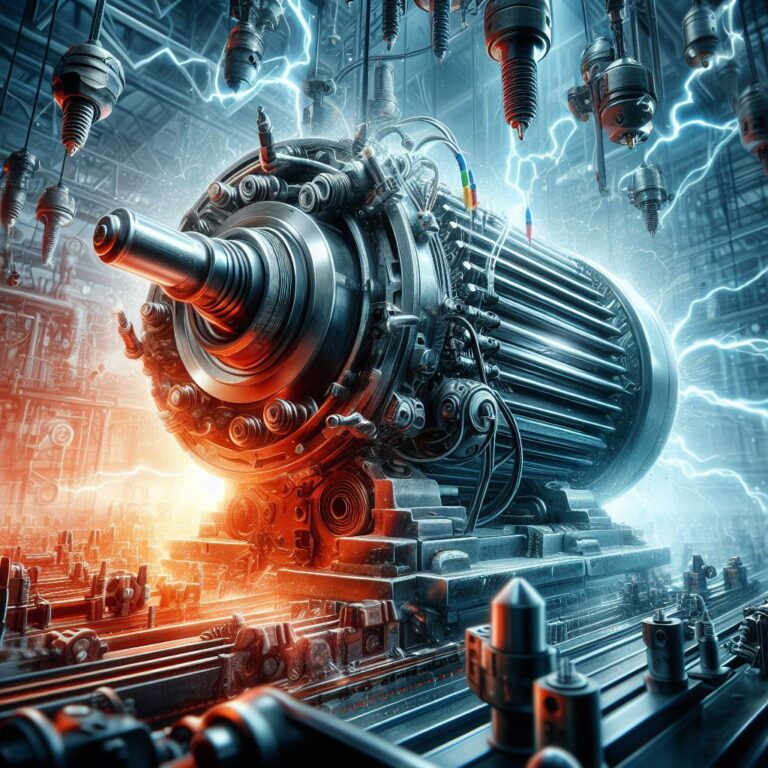Introduction: Why Solar Plant Cost in 2025 Matters More Than Ever
As 2025 unfolds, solar energy adoption is no longer a trend—it’s a necessity. With electricity tariffs rising steadily and climate change demanding urgent action, more homeowners and businesses in India and the USA are exploring solar as a long-term solution. But one question still dominates the conversation: How much does solar really cost? And more importantly—how does the residential vs commercial solar system cost compare in 2025?
Over the past few years, technological advances and supportive government policies have significantly reduced solar installation costs. However, there’s a wide variation based on system size, panel type, and application—especially between homes and businesses. Understanding the residential vs commercial solar system cost is now critical for making an informed investment decision.

For homeowners, the focus is often on reducing monthly bills and increasing property value. In contrast, businesses look at faster ROI, net metering benefits at scale, and sustainability commitments. This blog will break down everything you need to know about the residential vs commercial solar system cost, giving you clarity on which solar setup makes sense for your needs in 2025.
Key Factors That Influence Solar System Cost
When evaluating the residential vs commercial solar system cost, it’s essential to look beyond just the total price tag. Multiple factors determine how much you’ll pay—and what kind of value you’ll receive.
✅ System Size and Capacity
System size is one of the biggest cost drivers. Residential solar systems typically range between 1 kW and 10 kW, while commercial solar setups often exceed 50 kW or even go up to 500 kW or more. Naturally, higher capacity systems cost more upfront—but they also benefit from economies of scale. So, while a 100 kW system is more expensive than a 5 kW system, the cost per kW tends to be lower.
✅ Installation Type: Rooftop vs Ground-Mounted
Rooftop systems are common for homes and smaller businesses. They’re usually cheaper to install since they use existing roof space. In contrast, ground-mounted systems—more common in large commercial or industrial installations—may incur extra costs for land use, structural foundations, and trenching. This distinction greatly affects the residential vs commercial solar system cost.
✅ Solar Panel Technology
You can choose from polycrystalline, monocrystalline PERC, or bifacial panels. Residential users often prefer mono PERC panels for their better efficiency in smaller spaces, whereas commercial setups may opt for cost-effective poly panels in bulk. Panel type directly impacts both performance and pricing.
✅ Inverter Selection: String vs Microinverters
String inverters are cost-effective and work well for both residential and commercial systems with uniform panel orientation. Microinverters, though pricier, offer better efficiency on rooftops with varying shade or angles. Choosing the right inverter type plays a vital role in optimizing both system performance and overall costs.
✅ Battery Backup: Optional but Important
Adding a battery backup system increases reliability but also raises costs. Homeowners might choose batteries for backup during grid outages, while businesses might do so to reduce peak load charges. In either case, battery inclusion adds a layer of complexity to the residential vs commercial solar system cost analysis.
✅ Subsidies and Tax Credits
In India, homeowners can avail subsidies under the PM Surya Ghar Yojana (₹18,000/kW for systems up to 3 kW), while U.S. residents and businesses get a 30% federal tax credit through the Investment Tax Credit (ITC) scheme. These financial incentives significantly influence the upfront and lifecycle costs of any solar system.
✅ Installation Complexity and Site Conditions
Complex structures, taller buildings, shaded areas, or weak rooftops increase installation labor and material costs. This factor is especially relevant when comparing residential vs commercial solar system cost, as businesses often need more robust mounting structures or electrical work depending on the grid type.
💡 Pro Tip: Always compare cost per kW rather than the total system price. A 10 kW commercial system might appear costlier than a 3 kW residential one, but the value and long-term ROI often justify the difference.

Cost Breakdown: 5kW Solar System Price with Subsidy (for Homes)
As homeowners increasingly turn to clean energy solutions, a 5kW solar system has become one of the most popular choices. It’s perfectly sized for mid-sized households, and thanks to government support, it’s more affordable than ever.
🇮🇳 India: Affordable and Subsidized
In India, the 5kW solar system price with subsidy ranges from ₹2.3 lakh to ₹3.2 lakh before incentives. With the CFA (Central Financial Assistance) offered under national solar schemes, homeowners can get a subsidy between ₹78,000 and ₹1.05 lakh, depending on state policies and DISCOM approvals.
👉 Net cost after subsidy: ₹1.5 lakh to ₹2.3 lakh
👉 Monthly electricity savings: ₹4,000 to ₹6,000
👉 Payback period: 4 to 5 years
These figures make the 5kW Solar Plant Cost with subsidy extremely compelling for families looking to slash bills while increasing property value.
🇺🇸 USA: Tax Credits Lead to Big Savings
In the United States, a 5kW solar system typically costs between $12,000 and $16,000 before credits. However, thanks to the Federal Investment Tax Credit (ITC), homeowners can claim 30% back, bringing the net cost to just $8,400–$11,200.
👉 Monthly savings: $90 to $130
👉 Payback period: 6 to 8 years
Given rising electricity costs, the 5kW solar system price with subsidy in both countries offers a smart long-term investment for households.
Cost Breakdown: 10kW Solar Installation Cost for Homes or Small Businesses
A 10kW solar system is ideal for larger homes, multi-storey bungalows, and even small businesses such as clinics, retail stores, and guest houses. It delivers higher energy output and improved return on investment.
🇮🇳 India: Economies of Scale with Subsidy Support
The 10kW solar installation cost for homes in India typically ranges between ₹4.5 lakh and ₹6.5 lakh. Central subsidies of ₹1.3 lakh to ₹1.8 lakh can significantly reduce this cost.
👉 Net cost after subsidy: ₹3.2 lakh to ₹4.7 lakh
👉 Ideal for: Villas, 4–6 BHK bungalows, offices, clinics
👉 Estimated savings: ₹8,000 to ₹12,000 per month
👉 Payback: 4 to 6 years
The 10kW solar installation cost for homes may seem high initially, but with smart financing and subsidies, it offers excellent long-term value.
🇺🇸 USA: Powering Homes and Small Offices
In the USA, a 10kW solar system typically costs between $20,000 and $28,000 before the federal tax credit. After applying the 30% ITC, the net cost drops to $14,000–$19,600.
👉 Monthly savings: $180 to $250
👉 Payback period: 6 to 8 years
👉 Great fit for: Larger homes, home offices, or small business locations
📊 Comparison Snapshot (India):
| System Size | Gross Cost | Subsidy | Net Cost | Monthly Savings | Payback Period |
|---|---|---|---|---|---|
| 5kW | ₹2.3–3.2L | ₹78K–1.05L | ₹1.5–2.3L | ₹4K–₹6K | 4–5 years |
| 10kW | ₹4.5–6.5L | ₹1.3–1.8L | ₹3.2–4.7L | ₹8K–₹12K | 4–6 years |
The 10kW solar installation cost for homes and businesses is a step up in budget, but it also offers a much larger impact on energy bills and carbon footprint.
Cost Breakdown: 100kW Solar Plant Price for Factories, Offices, Schools
As industrial electricity bills soar and ESG mandates tighten, businesses are turning to solar energy at scale. A 100kW solar plant is a powerful solution for factories, commercial spaces, and educational institutions looking to cut down long-term energy costs and reduce carbon footprint.
🇮🇳 India:
- 100kW solar plant price for factories in India typically ranges between ₹42 lakhs to ₹60 lakhs, depending on location, type of panels used (mono PERC vs polycrystalline), inverter configuration, and mounting structure (rooftop vs ground).
- While no upfront subsidy is available for commercial solar, businesses can benefit significantly from accelerated depreciation under Section 32 of the Income Tax Act, reducing taxable income and improving ROI.
- Monthly savings for a system of this size range from ₹1 lakh to ₹1.5 lakhs, depending on usage and solar irradiation.
- Payback period is around 3 to 4 years, after which the system continues to generate free electricity for 20+ years.
- Best use cases: MIDC industrial units, cold storage warehouses, shopping malls, private schools, colleges, and government institutions.
🇺🇸 USA:
- In the U.S., a 100kW solar system costs approximately $100,000 to $150,000.
- After applying the 30% federal solar investment tax credit (ITC), the net cost drops to $70,000–$105,000.
- Businesses may also benefit from MACRS (Modified Accelerated Cost Recovery System), which further improves ROI.
- Annual savings can exceed $18,000 to $30,000, especially in high-rate states like California, New York, or Hawaii.
- Return on investment (ROI) is generally realized in 4 to 6 years, with potential to accelerate further if state-level incentives apply.
📊 Bar Chart Suggestion: Visual comparison of monthly/annual savings across system sizes (5kW, 10kW, 100kW) to highlight scale benefits.
ROI & Payback Period Comparison Across Systems
Whether you’re installing solar at home or for a large industrial site, understanding the return on investment (ROI) and payback period is key. Here’s a side-by-side comparison of typical costs and savings in both India and the USA, categorized by system size.
| System Size | Cost (India) | Cost (USA) | Monthly Savings | Payback Period |
|---|---|---|---|---|
| 5kW | ₹1.5L–₹2.3L | $8.4K–$11K | ₹4K–₹6K / ~$100 | 4–5 years |
| 10kW | ₹3.2L–₹4.7L | $14K–$19K | ₹7K–₹10K / ~$200 | 4–6 years |
| 100kW | ₹42L–₹60L | $70K–$105K | ₹1.5L / ~$2.5K+ | 3–6 years |
📌 Pro Tip: Use a solar ROI calculator India USA 2025 to determine exact savings based on your location, energy tariff, and system size. These tools can simulate long-term returns, factoring in inflation, subsidies, and local incentives.
Cost-Saving Tips Before You Install a Solar System
Installing a solar system in 2025 is a smart investment—but only if done wisely. Whether you’re in India or the USA, the solar ROI calculator India USA 2025 can help estimate how long it’ll take to recover your investment. But before you get to ROI, you need to cut unnecessary costs without compromising performance.
🔧 Smart Tips to Save More:
Check Net Metering Eligibility: Confirm with your DISCOM or utility provider whether net metering is allowed. This can drastically improve ROI.
Choose Mono PERC Panels: While slightly more expensive than polycrystalline, they offer better efficiency and space savings—especially useful for rooftop systems.
Select the Right System Type:
- On-grid if you have stable grid access and want lower costs.
- Hybrid if power outages are frequent or you want battery backup.
Always Get 3–5 Quotes: Pricing can vary greatly. A detailed comparison helps you spot inflated installation charges or hidden costs.
Demand a Cost Breakdown: Insist on an itemized quote—panel cost, inverter, structure, labor, GST, and any service charge. This keeps vendors transparent.
Check Warranty Coverage: Panels should offer 25–30 years of performance warranty. Inverters should have at least 8–10 years of coverage.
Before signing any contract, plug the data into a solar ROI calculator India USA 2025 to visualize returns. Use it to test scenarios like different system sizes, subsidy changes, or switching panel types.
FAQs About Solar System Cost in 2025
Whether you’re a homeowner or a factory manager, solar in 2025 raises a lot of financial questions. Here are some answers to the most common concerns.
❓ Is Solar Still Worth It in 2025?
Absolutely. With rising electricity tariffs and falling solar hardware prices, the ROI is better than ever. Both India and the USA offer incentives that significantly reduce upfront costs. Tools like the solar ROI calculator India USA 2025 show payback periods as short as 4 years for residential systems.
❓ What’s the Difference in Residential vs Commercial Solar System Cost?
The residential vs commercial solar system cost varies due to scale, installation type, and incentives. Commercial setups (like 100kW plants) benefit from economies of scale and depreciation benefits in India, while homes qualify for direct subsidies. Commercial costs per kW are usually lower, but total costs are higher.
❓ Can I Install with Zero Upfront via Leasing or EMI?
Yes. In the USA, solar leasing and PPAs (Power Purchase Agreements) are common. In India, many companies offer EMI financing for residential setups. Just make sure to factor in interest when calculating savings using a solar ROI calculator India USA 2025.
❓ How Much Roof Space is Needed for 5kW or 10kW?
- 5kW: 300–400 sq. ft
- 10kW: 600–800 sq. ft
It depends on panel type (mono vs poly). Mono PERC panels save space and are ideal for limited rooftops.
❓ Can I Expand My System Later?
Yes, modular solar systems allow upgrades. Discuss this upfront with your installer so the inverter and structure are expansion-ready.
Conclusion: Smart Solar Investment Begins with Clear Costing
Solar energy isn’t just about going green—it’s about achieving long-term financial freedom. In both India and the USA, a well-planned system can cut electricity bills by up to 90%.
Here’s a quick recap:
- Choose 5kW for small homes or apartments.
- Go for 10kW if you run ACs, heaters, or work from home.
- Opt for 100kW solar plants if you’re running a factory, warehouse, or institution.
Use tools like the solar ROI calculator India USA 2025 to make informed decisions and plan your investment wisely. The residential vs commercial solar system cost comparison is no longer just about money—it’s about value, independence, and future-proofing your lifestyle or business.
💡 Act now—government subsidies, net metering, and tax credits may not last forever. Secure your ROI before incentives disappear.
-
✅ Beginner’s Guide to Solar System for Factories and Industrial Rooftop Installations
Learn how to plan, size, and install a solar system for industrial use, with practical tips for businesses. -
🏠 What Is a Residential Solar Plant and How Does It Power Your Home?
A complete overview of how solar energy powers homes, including system components, savings, and benefits. -
☀️ DualSun Hybrid Solar Panels
Discover the dual-power panel that generates both electricity and hot water—ideal for maximizing efficiency. -
🌈 AuREUS Solar Panels are Changing Renewable Energy
Explore the game-changing tech that captures UV light—even on cloudy days—to produce energy. -
🏢 SolarWindow: Revolutionising Smart Building Technology
See how transparent solar coatings are turning glass buildings into vertical solar power plants.






